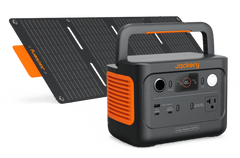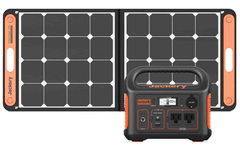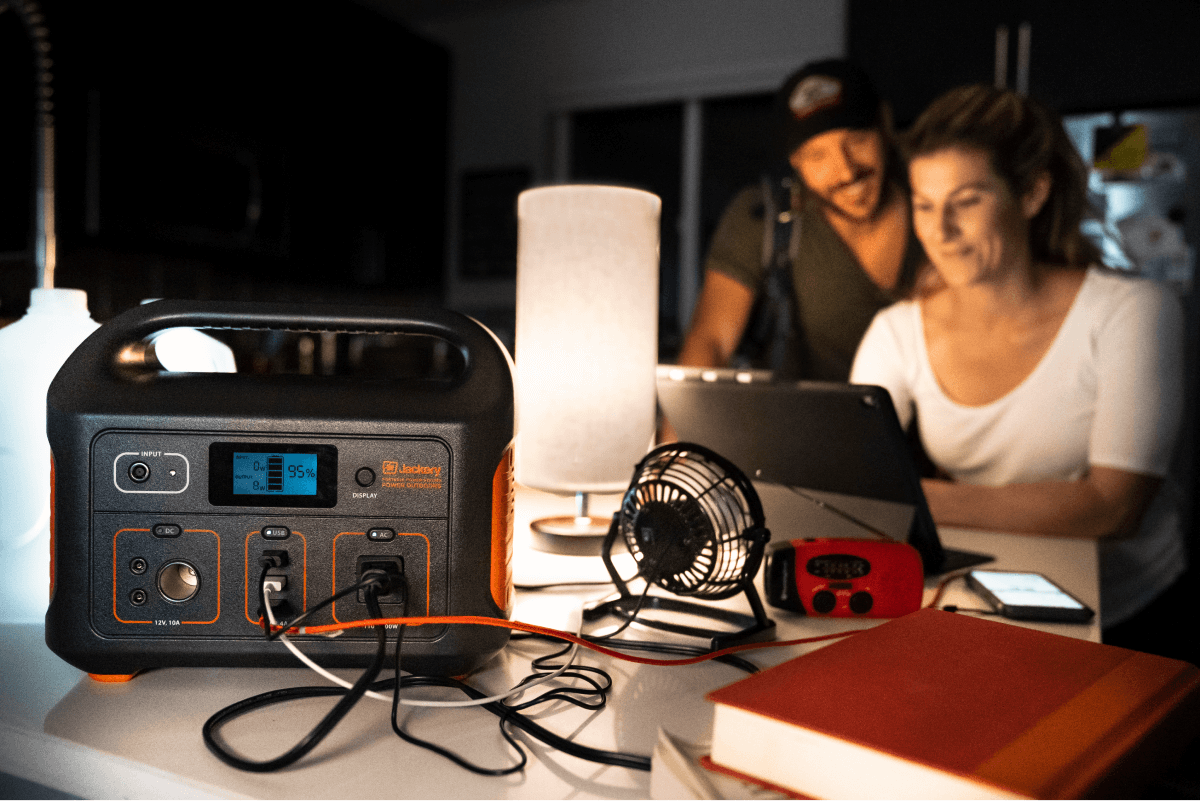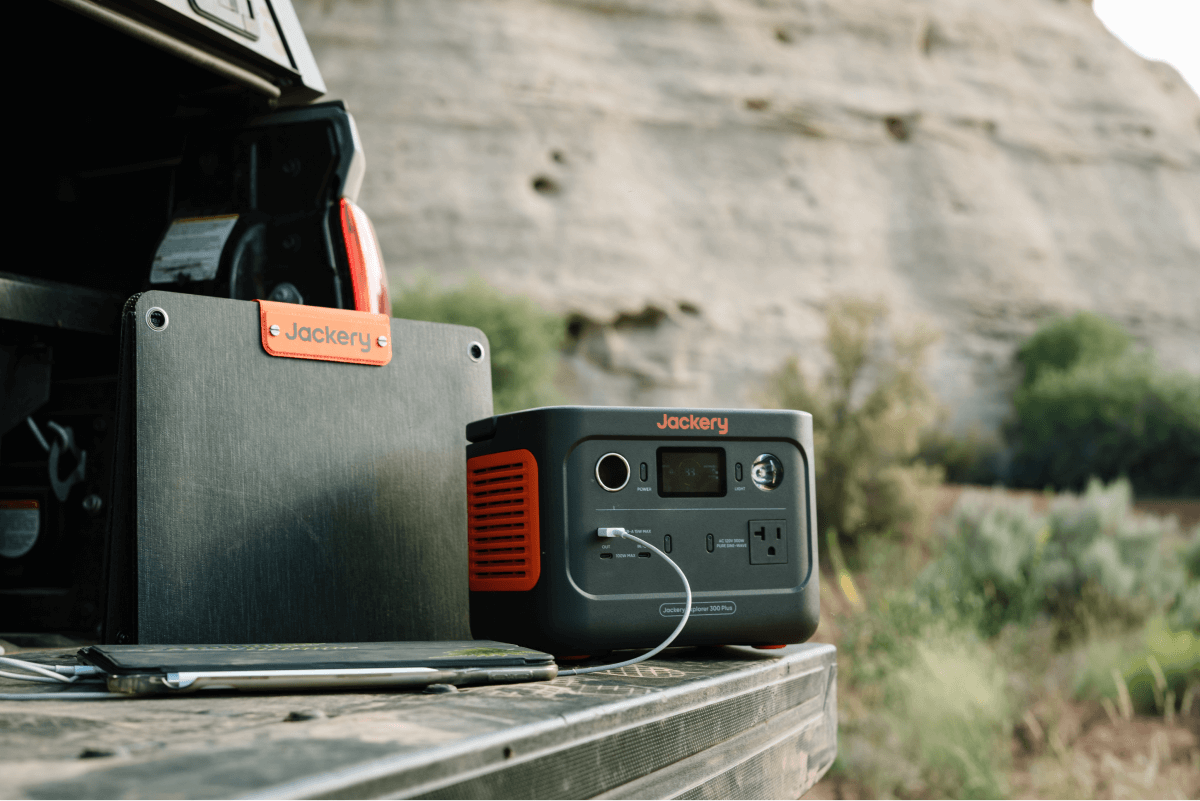How Many Watts Does A Modem Use?
The modem discreetly drives our digital activities, from remote work to relaxing streaming. However, have you ever wondered how many watts does a modem use? This article talks about the energy usage of this unsung hero and reveals the environmental implications of our connected society. As we connect online and offline, portable power solutions like Jackery contribute to the story. Understanding modem wattage is critical in a world where remaining connected is essential, particularly with novel power options.

Continue to read and learn how we decipher the energy dynamics of modems and their function in our day-to-day connection, all while investigating the harmonic synergy with portable power, which is exemplified by the effectiveness of devices like Jackery solar generators.
|
Products |
Image |
Capacity |
Rated / Peak Power |
Battery |
Size |
|
 |
518Wh |
500W/1000W |
NMC |
Length= 11.2in Width= 7.6in Height= 9.2in |
|
|
 |
288Wh |
300W/600W |
Li-Fe PO4 |
Length= 9.1in Width= 6.1in Height= 6.6in |
|
|
 |
293Wh |
300W/500W |
NMC |
Length= 9.1in Width= 5.2in Height=7.8in |
Modem Wattage Key Takeaways
Here are some facts to keep in mind about a modem and its wattage.
- In general, the power consumption of different kinds of modems ranges from 5 to 15 watts on average.
- Approximately ten watts of electricity is normally used by the majority of modern modems.
- When you use a modem for roughly 21 hours per week, the quantity of power that it consumes on a yearly basis is approximately 15 kWh.
- The yearly use of your modem multiplied by the average energy rate in your location will give you the cost of electricity.
- The wattage of a modem depends on its model, size, and type. There is a wide variety of modems based on professional or home use, and each one carries a different wattage.
How Many Watts Does A Modem Use?
Modems are small devices that mostly go unnoticed when talking about the power consumption of a house or workspace. Although these devices do not use much electricity they run 24/7 so it is essential to know, how many watts does a modem use?
Average Modem Wattage:
The usual power of a modem is 5 to 15 watts. Different models, technologies, and features of modems may result in somewhat different specific wattages. In order to evaluate the modem's energy efficiency and environmental effect, knowing the average wattage is essential.
Wattage of Different Types of Modems:
Many variables, like the purpose, functionality, and general design, may affect the wattage of various modem types, including internet modems and cable modems. In broad strokes, here it is:
Cable Modems:
How many watts does a cable modem use? Cable modems, which use cable TV lines to connect to the internet, often have 5–15 watts. The modem's processing power, built-in routers, and data transfer efficiency may all impact its wattage.
DSL Modems:
Broadband connections using telephone lines, known as digital subscriber line (DSL) modems, often fall within the same wattage range as cable modems, which is 5 to 15 watts. Data transmission speed and built-in technologies for increased performance are two modem characteristics that could impact the wattage.
Optical Fiber Modems:
Internet modems that are specifically made for fiber optic connections often fall within the same wattage range. One possible detrimental impact of the cutting-edge technology used by fiber optic modems is its reputation for lightning-fast data transfer.
Integrated Modem-Router Devices:
You may get modems that can operate as routers. The combined modem and router functions could cause these devices to use a little more power, usually between 10 and 20 watts.
Modem Wattage per Hour:
A modem's wattage per hour is the same as its listed or running wattage. If you take a 20-watt modem and use it for one hour, it will use 20 watts of electricity or 0.020 kWh. Idle or standby modes, often called vampire or standby power, may cause certain modems to use less power. Even when the gadget is not actively sending data, it still consumes power.
For accurate long-term consumption analysis and smart energy conservation choices, knowing a modem's hourly watts is crucial. You may get more exact information about the power consumption of the device by reading the specifications given by the manufacturer of the modem.
Modem Electricity Usage:
If you are wondering how many watts does an internet modem use? Here is a simple table and some calculations to figure it out.
|
Wi-Fi Router Wattage |
Hours per Year Run |
Yearly kWh of Electricity |
|
5W |
8760 Hours |
43.8 kWh |
|
10W |
8760 Hours |
86.7 kWh |
|
15W |
8760 Hours |
131.4 kWh |
|
20W |
8760 Hours |
175.2 kWh |
Calculate the Electricity Usage of the Modem:
Check the Wattage:
To discover the wattage rating, see the modem's specs or user handbook. In most cases, the manufacturer will provide this data.
Calculate Per Day Use:
Calculate an approximation of the daily active use time of the modem. As an example, consider your daily use if it runs for 8 hours each Day.
Do a Watt-hour calculation Every Day:
To get the daily operating hours of the modem, multiply its wattage by that amount. The modem's daily watt-hour consumption may be found here.
Watt-hours per Day = Device Wattage x No. of Hours
Find the Annual Use:
To get the annual watt-hour consumption, multiply the number of days the modem is used by the daily watt-hours.
Watt-hours per Year = Watt-hours per Day x 365
Find the kWh value:
If you know the electricity usage of your modem, getting a kWh value is simple. Do your calculation, and when you get the wattage number, divide it by 1000 to get the value in kilo-watt-hours.
Electricity Usage in kWh = Watt-hours per Year/1000
Calculate Electricity Cost:
Start by checking the cost of electricity per kilowatt-hour in your region. You can create an estimate of the annual power cost of your modem by multiplying the yearly kWh by the cost per kWh at the time of calculation.
How Much Does It Cost to Run A Modem?
If you want to know how many watts does a modem use to find out how much it adds to your electricity bill remember that the consumption of energy and related monetary costs make up the total cost of operating a modem. Here is an example table that summarizes the projected expenses according to the preceding estimates; this should assist in clarifying the situation. Keep in mind that things like local power prices, modem efficiency, and use patterns might affect the real expenses.
|
State |
Average Electricity Rate |
Cost per Month |
Cost per Year |
|
Washington |
$0.10 / kWh |
$1.04 |
$9.09 |
|
Maryland |
$0.14 / kWh |
$0.76 |
$12.68 |
|
New Jersey |
$0.16 / kWh |
$1.06 |
$14.19 |
|
Virginia |
$0.12 / kWh |
$1.18 |
$11.02 |
|
Florida |
$0.12 / kWh |
$0.92 |
$10.70 |
|
Massachusetts |
$0.22 / kWh |
$0.89 |
$19.79 |
|
Texas |
$0.12 / kWh |
$0.92 |
$11.00 |
|
New York |
$0.20 / kWh |
$1.50 |
$18.04 |
|
California |
$0.22 / kWh |
$1.61 |
$19.27 |
|
US Average |
$0.14 / kWh |
$1.04 |
$12. |
The cost of operating a modem is calculated by calculating power usage by cost per unit. Steps and a formula for cost calculation:
- Determine Modem Power Consumption
- Estimate Daily Energy Use
- Calculate Monthly Energy Use
- Check the Electricity Price
Multiply monthly kWh usage by cost per kWh. Monthly Cost = Monthly Energy Consumption x kWh Cost.
Formula Summary:
Modem Power Rating (kW) = W / 1000
Daily Energy Consumption (kWh) = Modem Power Rating (kW) x Hours On Monthly Energy Consumption (kWh) = Daily kWh x Days in Month Monthly Cost = Monthly kWh x Cost per kWh
Example:
Say your 10-watt modem runs 24/7. Consider $0.12 per kWh:
Modem Power Rating = 10 W/1000 = 0.01 kW
Daily energy consumption = 0.01 kW x 24 hours = 0.24 kWh
Monthly Energy Consumption = 0.24 kWh x 30 days = 7.2 kWh
Monthly Cost = 7.2 kWh x $0.12 = $0.864
Thus, this modem's projected monthly cost is $0.864.
Jackery Solar Generators for Modems
The Jackery Solar Generators use solar panels to collect sunlight and make electricity. The solar energy hits these panels and turns them into electricity. An integrated battery stores the power. The generator then uses an inverter to change the DC power it has saved into AC power that can be used by different appliances and devices.

Solar Generator 500 for Modem

Capacity: 518Wh
Rated/Peak Power: 500W/1000W
Battery: Li-ion NMC
Size: Length 11.2 in, Width 7.6 in, Height 9.2 in.
Lifespan: 500 cycles to 80%+ capacity
Charging Methods: Solar panels, AC outlet, car charger
Features: Various output ports, lightweight design
Solar Generator 300 Plus for Modem

Capacity: 288Wh
Rated/Peak Power: 300W/600W
Battery: Li-Fe PO4
Size: Length 9.1 in, Width 6.6 in, Height 6.1 in.
Lifespan: 3000 cycles to 80% + capacity
Charging Methods: Solar panels, AC outlet, car charger
Features: It has multiple output ports and is lightweight and easy to carry
Solar Generator 300 for Modem

Capacity: 293Wh
Rated/Peak Power: 300W/500W
Battery: Li-ion NMC
Size: Length 9.1 in, Width 5.2 in, Height 7.8 in.
Lifespan: 500 cycles to 80% + capacity
Charging Methods: Solar panels, AC outlet, car charger
Features: Its seamless operation, multiple charging options, and compact design make it an indispensable addition to any household.
|
|
Solar Generator 500 |
Solar Generator 300 Plus |
Solar Generator 300 |
|
Capacity |
518Wh |
288Wh |
293Wh |
|
Cycle Life |
500 cycles to 80%+ capacity |
3000 cycles to 80% + capacity |
500 cycles to 80% + capacity |
|
Battery Cell |
Lithium-ion |
Li-Fe PO4 |
Lithium-ion |
|
Dimension |
(11.2 x 7.6 x 9.2) in |
(9.1 x 6.6 x 6.1) in |
(9.1 x 5.2 x 7.8) in |
|
Recharging Methods |
Solar panels, AC outlet, car charger |
Solar panels, AC outlet, car charger |
Solar panels, AC outlet, car charger |
|
Output Port |
AC Output(x1), DC Output(x2), USB-A Output(x3)
|
AC Output(x1), USB-A Output(x1), USB-C Output(x1), USB-C Output(x2), |
AC Output(x2), USB-A Output(x1), USB-C Output(x1),
|
|
Working Hours |
15.4H for a 15W Modem |
27.6H for a 15W Modem |
15.6H for a 15W Modem |
Wattage of Modem FAQs
Do modems and routers use more power on internet usage?
No, modems and routers consume a relatively low amount of power. Their energy usage is not significantly affected by internet usage.
Can I use a power station for the modem and router?
Yes, you can use a power station like Jackery Portable Power Stations to power your modem and router. They are designed for small electronic devices and are convenient for outdoor or backup power.
What size of generator do I need to run a modem?
If you only want to run a modem, a 300 to 500-watt generator is good enough. For that, using Jackery solar generator 500, 300 Plus, or 300 is the best as it will help you power your modem with green energy. Here is how you can calculate how long you can run your circular saw with Jackery portable generators.
Working Hours = (Battery Capacity in WH) × 0.85 / (Device Power Consumption in W)
How many watts is a TP-Link modem?
The power consumption of TP-Link modems can vary, but on average, they typically use around 10 to 15 watts.
How many watts does a 12V router use?
12V routers generally consume around 5 to 15 watts, depending on the specific model and features. It's advisable to check the router's specifications for accurate information.
Final Thoughts
Let’s conclude our guide on how many watts does a modem use? Routers or Modems are small devices that don't use a lot of electricity, so they don't contribute much to the monthly electricity bill even if they run 24 hours a day. Knowing or not knowing the wattage of a modem doesn't make a difference as long as you are using grid energy to power it. With Jackery solar generators, you can power your devices and appliances with solar energy. Jackery offers the best portable power solutions to provide green and cost-free electricity.
Disclaimer:
The runtime mentioned for appliances powered by Jackery is for reference only. Actual runtime may vary under different conditions. Please refer to real-world performance for accurate results.





































![[Add - on] Jackery Manual Transfer Switch for Explorer 5000 Plus - Jackery](http://www.jackery.com/cdn/shop/files/add-on-jackery-manual-transfer-switch-for-explorer-5000-plus-9017324.png?v=1754016782&width=170)
























































































Leave a comment